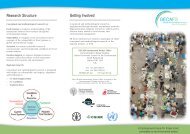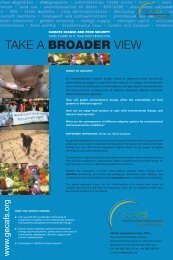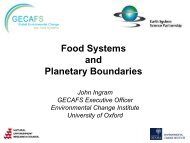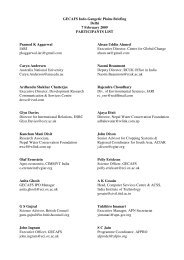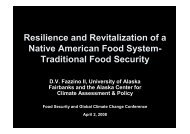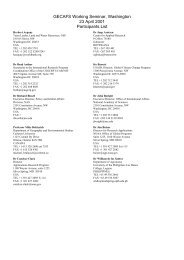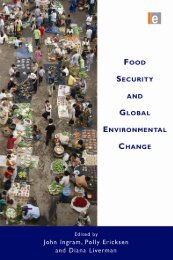From Food Production to Food Security - Global Environmental ...
From Food Production to Food Security - Global Environmental ...
From Food Production to Food Security - Global Environmental ...
- No tags were found...
Create successful ePaper yourself
Turn your PDF publications into a flip-book with our unique Google optimized e-Paper software.
Stakeholders’ participation in GEC science needs <strong>to</strong> be founded upon a mutualunderstanding of their contributions <strong>to</strong> the project and the benefits they will derive.Stakeholders make multiple contributions <strong>to</strong> GEC science, ranging from establishing theresearch agenda <strong>to</strong> participating in data collection <strong>to</strong> capacity building.Stakeholder participation in GEC science must be in accordance with international andnational law as well as consistent with local norms for the sharing of knowledge andbenefits.Stakeholder participation needs <strong>to</strong> be a planned set of activities within the GEC scienceprocess and be based upon an adaptive research design.GEC science must avoid overtaxing stakeholders and recognize that stakeholders haveunequal capacities.The GEC science community has a responsibility <strong>to</strong> maintain and manage an environmentthat fosters long-term stakeholder participation.As noted above, stakeholders choose <strong>to</strong> participate in various stages of the scientific process,but seldom participate in all. Brklacich et al. (2007) give an example of how planningagencies both helped define a river management study in the Amazon and also then helpedcommunicate the project’s findings. Increasingly, however, there is a view that the researchprocess cannot meet stakeholder needs unless they, in fact, participate throughout theresearch process.A particular example is the concept of co-production of knowledge, which is increasinglybecoming a central feature of major research initiatives (e.g. UK’s Living with<strong>Environmental</strong> Change programme; LWEC, 2009). An additional example is provided by theFamine Early Warning System (FEWS NET) project of the US Agency for InternationalDevelopment (USAID) (Box 5). A key insight <strong>to</strong> emerge from FEWS NET concerns theimportance of engaging a range of stakeholders in order <strong>to</strong> achieve consensus at the researchcommunication stage: once they agree <strong>to</strong> the nature and scope of the problem and come <strong>to</strong> thetable <strong>to</strong> discuss what <strong>to</strong> do about it, they are able <strong>to</strong> determine what actions will help relievethe most intense symp<strong>to</strong>ms of the food security crisis.Box 5 Building consensus among stakeholders: A FEWS NET example.USAID designed FEWS NET in 1986 <strong>to</strong> provide information on food security of communities insemi-arid regions so that widespread climate-related food security crises do not occur. FEWS NETincludes stakeholders who work in the public, private or non-profit sec<strong>to</strong>rs in the region, and whoseidentities vary widely depending on the location. In some regions, the meteorological communitiesand health care workers are at the centre; in others it is nutrition experts from government and tradenetworks.The primary objective of early warning systems is <strong>to</strong> elicit an appropriate response <strong>to</strong> an identifiedproblem. Often, this requires that all stakeholders, from the various donors of food aid, regional75



